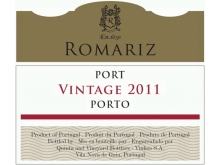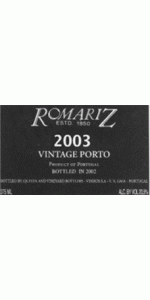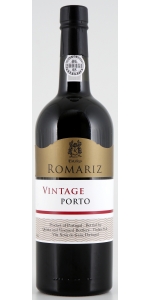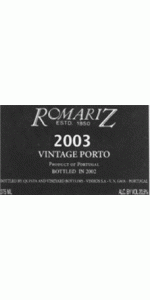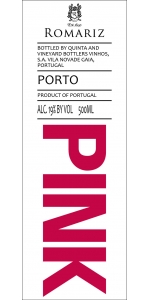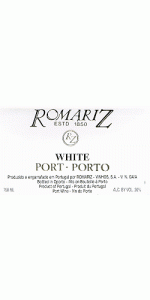Romariz Vintage Port 2011
| Country: | Portugal |
| Region: | Douro |
| Winery: | Romariz Port |
| Grape Type: | Port Blend |
| Vintage: | 2011 |
| Bottle Size: | 750 ml |
Flowering in the Duoro occurred in the last 10 days of May. The weather conditions provided for a perfect flowering season. The Romariz Vintage Port 2003 yielded wines of great color and supple tannins, with a vintage stamp being evident in most wines. Production: 8,000 cases. "Another bright and fruity young Vintage Port with plum, grape and blackberry aromas with just a hint of stems. Serious nose here. Full-bodied, with soft, round tannins and a long, caressing finish. A beauty."
- J.S., Wine Spectator, 89-91 pts
"Bright dark ruby. Deep, perfumed aromas of cassis, licorice, violet and minerals. Lush and high-toned in the mouth but with very good vinosity and spine. Lovely fruit-driven flavors of black cherry, blackberry and dark chocolate. Little sign of the roasted side of 2003. Not hugely concentrated but suave, supple, minerally and sweet. Finishes with ripe tannins and very good spicy persistence. A very good showing. Accessible already but balanced for medium-term aging."
- Stephen Tanzer's International Wine Cellar, 89 pts
Romariz Vintage Port is made from Touriga Nacional, Touriga Franca, Tinto Cão, Tinta Roriz, Tinta Barroca
Deep inky purple color. Intricate nose with aromas of blackberries and logan berries, subtle hints of amber and spring blossom and delicate spice. A tight, well-formed palate with an abundance of dark berry fruit, rich chocolate and liquorice, culminating in a long finish. Firm, closely woven tannins that give the wine great structure and body. An elegant finely constituted Vintage Port which will drink beautifully now or age quietly in the cellar.
A vintage port is made from blended grapes, all from the same vintage year. Vintage ports are historically only declared every 3 out of 10 years. Romariz vintage ports age for up to two years in oak, then go unfiltered into the bottle for further aging.
"Opaque ruby. A complex, beautifully structured wine from Europe’s hot summer of 2003. Lively spicy, toasted aromas and a ripe and generous palate with layers of rich, dense flavors of dark fruit, chocolate, tobacco, spice box and a hint of marmalade. Finishes dry and long with still firm tannins. A delicious Port that should be paired with Roquefort and other blue cheeses."
- International Wine Review (Succulent Sweet Wines for the Holidays: The Best of 2018), 92 pts
Romariz Pink Port is from a blend of red grapes port is the beautiful deep pink color extracted. Then rose postage, like white port, vinified without the skins. Despite Romariz not the Fonseca label bears, this port by a team led by David Guimaraens. The grapes after pressing 7 days sur lie cold fermented. This slow fermentation, which lasts twice as long as usual, brings a delicious berry hurry up and crisp, bright and airy style that is so characteristic of Romariz Pink Rose Port.
Aromatic fruit aromas of raspberries and currants with floral tones. Full, fruity taste with ripe cherries and raspberries and notes of honey and of course grapes. Modern, bright and airy style.
Romariz Pink Rose Port is a delicious appetizer with a lump of ice, but can also be combined well with fruit desserts. Furthermore, this port is an interesting combination as long drink with tonic and a slice of lemon.
Romariz White Port is a blend of wines from the Arinto, Boal, Codega, Esagna CAO, Folgasao, Gouveio, Viosinho, and Rabigato grapes grown in the Douro. This is aged in oak for three years. Aromas of fruit cocktail, round and full, orange-nutty undertone, strong flavored and sweet. Refreshing summertime drink on ice.
FOOD MATCH: Served alone for after-dinner sipping.
The winter preceding the 2011 harvest was wetter and colder than the 30-year average. Budburst occurred as usual around 19th March and warm weather and rainfall in April produced vigorous growth. At the beginning of May dry conditions set in and there was little rainfall in eastern areas of the Douro Valley until late August. However the vines were able to draw from the plentiful ground water reserves built up early in the year and bunches developed and ripened in ideal conditions. Véraison (coloring of the grapes) occurred a little earlier than usual on 15th June.
Mild weather in June and July was broken only by a heat wave in the second half of June. August was hot and dry, with perfectly timed rainfall on 21st August and 1st September rounding off an excellent ripening season and producing a well-balanced crop. Picking started in mid September in the Cima Corgo area of the Douro Valley. Fermentations were long, allowing balanced and complete extraction, and musts displayed intense color and powerful fruit character from the outset.
Deep inky purple color. Intricate nose with aromas of blackberries and logan berries, subtle hints of amber and spring blossom and delicate spice. A tight, well-formed palate with an abundance of dark berry fruit, rich chocolate and liquorice, culminating in a long finish. Firm, closely woven tannins that give the wine great structure and body. An elegant finely constituted Vintage Port which will drink beautifully now or age quietly in the cellar.
The Romariz Port Estate
The port house of Romariz was founded in 1850 by Manoel (Manuel) da Rocha Romariz. Manoel was a descendant from a well known Oporto family.
Over the years, Romariz developed business dealings in Brazil and other Portuguese Colonies (Africa and China), and to a lesser extent England. Historically, Romariz was known for wood ports, like Colheitas (single vintage Tawnies) and in top years vintage ports.
In 1966, the Romariz family sold their brand and business to Guimaraens & Co. (who own Fonsecca) and the business continued on. Some years passed by and eventually Fonsecca and Taylor’s joined forces. Today, Fonsecca, Talyor and Romariz share the same winemaker and facility in Vila Nova de Gaia.
Today, Romariz offers a wide range of Ports: wood, vintage, LBV’s and Colheitas. Their main markets are Portugal, Denmark and France. All grapes come from region #2, Cima Corgo, the heart of the best growing area along the Douro River. Romariz being a “Portuguese” port firm, adheres to a rich warm style of port wines.
Romariz Pink Port is from a blend of red grapes port is the beautiful deep pink color extracted. Then rose postage, like white port, vinified without the skins. Despite Romariz not the Fonseca label bears, this port by a team led by David Guimaraens. The grapes after pressing 7 days sur lie cold fermented. This slow fermentation, which lasts twice as long as usual, brings a delicious berry hurry up and crisp, bright and airy style that is so characteristic of Romariz Pink Rose Port.
Aromatic fruit aromas of raspberries and currants with floral tones. Full, fruity taste with ripe cherries and raspberries and notes of honey and of course grapes. Modern, bright and airy style.
Romariz Pink Rose Port is a delicious appetizer with a lump of ice, but can also be combined well with fruit desserts. Furthermore, this port is an interesting combination as long drink with tonic and a slice of lemon.
- back
Wine Gift Set Includes:
- Laurent-Perrier La Cuvee Brut
The wine comes from the purest grape juice and it alone allows Laurent-Perrier to craft 'La Cuvée', a champagne of great finesse and a beautiful freshness obtained after a long ageing process in our cellars.Pale gold in color. Fine bubbles feed a persistent mousse. A delicate nose with hints of fresh citrus and white flowers. The wine’s complexity is expressed in successive notes like vine peach and white fruits notes. A perfect balance between freshness and delicacy with fruity flavors very present on the finish. This fresh and pure wine is perfect for an apéritif. Its citrus and white fruits notes and its remarkable balance supported by a subtle effervescence, make it an ideal accompaniment to poultry and the finest fish.
Gold Gift Box
Review:
"The brioche and cooked-apple and cream character really comes through here. Full-bodied and round with fine bubbles. Flavorful and intense. Vivid, bread-dough finish. This is four years on lees. 55% Chardonnay and the rest Pinot."
- James Suckling 93 Points
Long Shadows Poets Leap Riesling is made from 100 percent Riesling.
Tasting Notes: The Poet's Leap Riesling offers aromas of white peach, jasmine, Thai basil and nutmeg. Flavors of ripe melon, apricot and an appealing minerality continue across the palate. An underlying hint of honey sweetness is balanced by a streak of bright acidity that provides a long, clean finish.

